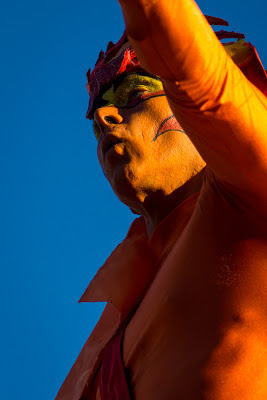Gegenlicht - the German term for light that shines into the camera from the other side of the photographer's subject - literally means "against light." Artists always have things going against them or they wouldn't have to struggle, right? And if there's no struggle, there's no art, right? In these photos from a shoot in early September, the sun was with us just long enough to get a few good shots, but we had to play with the back light to get it right.
If it's not the light, it's the equipment (usually a weak excuse) or lack of knowledge or a bad mood or any number of other things that work against us on any given day. But let's concentrate on that all-important factor for photography today: light.
In the studio you try to project light on your subject in a way that creates a three-dimensional impression on the viewer, making the subject look real. Out in the field, however, that's usually not possible. There is usually only one source of light and - in event photography at least - you rarely have the opportunity to place a subject in a position that creates a perfect mixture between light and shadows. So you have the choice of either placing yourself directly in the sun and shooting into the light or working around the lighting situation in another way. Perhaps you shoot into the light and add a little of your own, either with a reflector or a flash.
In Ludwigsburg, just north of Stuttgart, there is a weekend-long event every two years, during which nearly 1,000 people dress up in fantastic costumes and parade around the city, much to the enjoyment of nearly 1,000 photographers!
The people behind the masks act stately and saunter around grandly as if they belonged to the aristocracy. Who knows what they are really like? Does it matter? The photographer is interested in the superficial beauty in this case. Perhaps he projects his feelings onto the one or other beauty, only to be disappointed once she is unmasked.
The parade on Friday goes through town and ends on the closed market place, where viewers must pay a fee to enter. There are several stages set up, on which magic, music and acrobatic shows are on continual rotation. All this makes for a real spectacle.
Here is a short video of this show.
During the parade I shot into the light most of the time, earning a comment from this gentleman about the fact that he thought the pictures wouldn't come out well.
After a while, though, you figure out just how directly you can shoot into the sun and how much you must compensate for the light.
Changing sides of the street and shooting with the light also has its advantages. With 1,000 people walking by, you are bound to get a few lucky shots if you keep your eyes open. Contrasting colors are always nice!
I am not sure I could have reproduced the light on this beauty as well as nature did that day.
Sometimes a bit of negative space adds a sense of mystery to a picture.
I must admit that when I went to the parade this year, I was not sure I'd be able to get any interesting shots. Two years ago I had been blown away by the masks and ambiance of the place. My expectations were high and my standards even higher. So trying to capture something new, I intentionally blurred my vision and shot into the light. Depending on the shutter speed and aperture, the light looks totally different. These two pictures were taken one minute apart.
















Interesting! Similar idea in drawing/painting, called contre-jour lighting in French. http://gurneyjourney.blogspot.com/2007/10/contre-jour-lighting.html
ReplyDeleteI enjoyed reading your post about contre-jour lighting in painting. With the extended dynamic ranges and HDR possibilities of the current generation of digital SLR and SLT cameras, it is possible to brighten up what is left in the shadows, though sometimes that makes the photograph look fake. In painting this inconsistency doesn't seem to bother the viewer as much.
Deletei have been looking for this on the internetPhotographs and pictures of sun
ReplyDelete